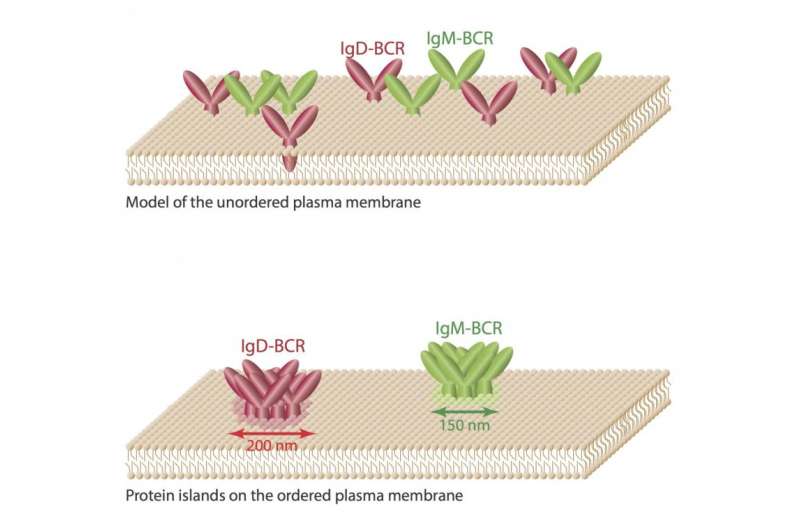Researchers apply super-resolution methods to study organization of receptors on B lymphocytes

Antigen receptors on B lymphocytes sense foreign molecules, such as pathogens or vaccines, and activate the B cells to produce antibodies that protect humans against many diseases. Prof. Dr. Michael Reth, Scientific Director of BIOSS Centre for Biological Signalling Studies, and his group have applied three different super-resolution methods to study the distribution of the two major classes of antigen receptors on mature B lymphocytes: IgM and IgD. It had been previously assumed that all proteins on the membrane, including receptors, are freely diffusing molecules that only become organized upon binding to specific ligands. Reth's group found out that IgM and IgD receptors are organized in protein islands.
The researchers from the University of Freiburg collaborated with Prof. Dr. Hassan Jumaa from the University of Ulm/Germany and Prof. Dr. Björn F. Lillemeier from the Salk Institute in La Jolla/USA. The imaging analysis was conducted in collaboration with Dr. Olaf Ronneberger's group, computer scientist at the University of Freiburg. The team has published their research findings in the journal Science Signaling. The researchers hope that these new insights into the nanoscale organization of antigen receptors will support the design of more efficient vaccines or better treatments for B cell tumors where membrane organization is often altered.
Using two-color direct stochastical optical reconstruction microscopy (dSTORM), the researchers found that IgM and IgD reside on the plasma membrane of resting B cells in separated protein islands of approximately 150 and 240 nanometers (nm), respectively. This class-specific compartmentalization of the antigen receptors is also detected by transmission electron microscopy (TEM) and Fab-based proximity-ligation assay (Fab-PLA) studies. Upon B cell activation, the IgM and IgD protein islands became smaller and the two classes of receptors are now found in close proximity to each other.
These studies provide direct evidence for the nanoscale compartmentalization of the lymphocyte membrane. Furthermore, they suggest that upon B cell activation, the different IgM and IgD protein islands form nano-synapses which allow the exchange of lipids and proteins. This could explain how the IgM class antigen receptors find contact to Raft-associated lipids and proteins. The association of IgM with these lipids is a well-known hallmark of B cell activation.
Michael Reth is professor of molecular immunology at the Institute of Biology III at the University of Freiburg and speaker of the Cluster of Excellence BIOSS Centre for Biological Signalling Studies. Palash Maity, lead author of the study, is a postdoc at BIOSS and at the Max Planck Institute of Immunobiology and Epigenetics in Freiburg. Olaf Ronneberger is working at the Institute of Computer Science. Ronneberger and Hassan Jumaa are both members of BIOSS Centre for Biological Signalling Studies. This study is part of the BIOSS nanoscale explorer program (BiNEP), which is a focus topic in the BIOSS-2 research program. In this program, BIOSS is developing methods to better understand the nanoworld of signaling processes, beyond the 250 nm diffraction limit of visible light.
More information: Palash Chandra Maity, Amy Blount, Hassan Jumaa, Olaf Ronneberger, Björn F. Lillemeier and Michael Reth (2015). B cell antigen receptors of the IgM and IgD classes are clustered in different protein islands that are altered during B cell activation. Science Signaling.
Journal information: Science Signaling
Provided by BIOSS - Centre for Biological Signalling Studies



















